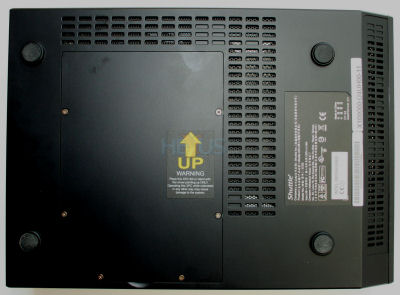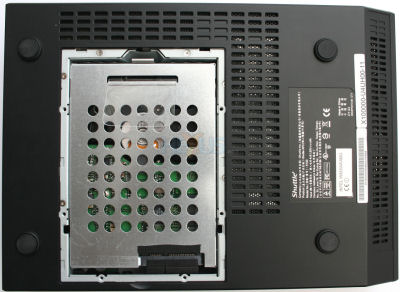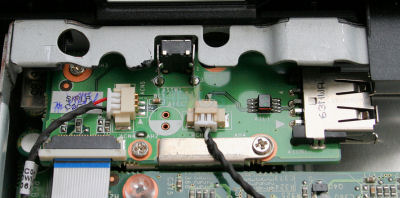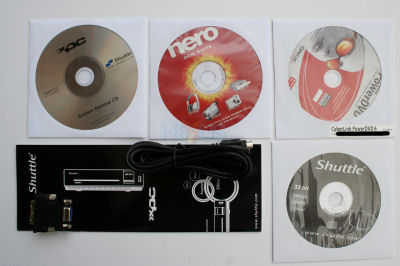Internal musings, noise, heat, power, warranty

So it's a laptop without a screen, right? Not quite.
Shuttle's design team has understood that shipping a system, however small, with a laptop hard drive will limit the appeal of the X100HA.

The X-type chassis is just tall enough to accommodate a single 3.5-inch hard drive and optical drive slid directly above it. Using the ICH7-M's on-chip SATA support, Shuttle adds a single 200GB Samsung SpinPoint drive to the basic configuration. You can, of course, decide to increase capacity at the point of sale and we'd urge prospective buyers to opt for the largest drive they can afford. There's no reason why you couldn't install a 750GB Seagate 7200.10 should funds permit.
Removing the drive highlights a small fan that provides a modicum of airflow to the hard disc. There's just enough ventilation to stop the drive from overheating, we reckon.

Turning the chassis around and popping off the lid via the three holding screws on the rear, we see how Shuttle has gone about cooling. The heatpipe-covered Intel Core Duo T2050 CPU, a dual-core SKU that's peculiar to laptops and not listed on Intel's site, operates at 1.60GHz but runs off a 133MHz FSB. Its 31W TDP and therefore excellent performance-per-watt ratio makes it a decent choice for Shuttle, whose main design goal for the X100HA is to offer reasonable performance with near-silent operation.
Shuttle also uses a similar heatpipe approach to cooling the ATI Mobility Radeon X1400 (MXM type II) non-HyperMemory graphics card that features 128MiB of onboard memory and, as we've seen on the previous page, both DVI-I and S-Video output connectivity. It communicates with the motherboard via a x16 PCIe interface and features two vertex shaders and four pixels shaders (one quad) with the core clocked in at 445MHz and memory, via a 128-bit bus, at 675MHz. That, folks, is around 11GB/s of local bandwidth.
ATI/Shuttle will promote the card on both its 2D/3D qualities and state that it's powerful enough to support Microsoft's upcoming Vista OS in all its graphical glory but don't let the PR fool you into thinking that its X1400 naming will give it the necessary power to pass muster with the latest games: it won't. The basic architecture simply doesn't have the grunt required for high-resolution gaming. It's a slightly faster-clocked Mobility Radeon X1300 and nothing else, and it will benchmark at sub-X1300 Pro (desktop) levels. We'd liked to have seen Shuttle implement the more-potent MR X1600 in the X100, really.
Shuttle's distributors are charging around £820 for this base unit but Shuttle has chosen to outfit this SKU with a total of 512MiB of DDR2, represented by two Samsung SODIMMs. We've got two reservations with this. Firstly, whilst the £30-£40 saving over specifying 1GiB of RAM will look good to the accounting department, any system that costs >£750 absolutely needs 1GiB as standard; no ifs and buts.
Secondly and somewhat relatedly, 512MiB will hinder performance and your Windows XP experience with constant accesses to the hard drive for data retrieval. We'd much rather Shuttle charges an extra £40 and specifies 1GiB. We see that Ambros Direct, one of Shuttle's partners, uses common sense and does exactly this with its SKU.

A closer look to the left highlights Intel's 3945ABG WiFi card that makes up one-third of the Napa platform. Look a little further to the left and you can see a neat hardware addition. It's an internal USB connector that any small-ish device can be connected to at the point of assembly.
Should the buyer wish to have, say, Bluetooth support, Shuttle can slot in a compliant device in to the USB port. There's no messing around with adding special ASICs or proprietory connectors on the board. As with most good ideas, it's simple and elegant.

The X100HA ships with Microsoft XP Home Service Pack 2 and the associated software that's bundled in with graphics cards and DVD drives, specifically Nero OEM Suite 6.0 and CyberLink's PowerDVD 6.0. Further, Shuttle adds in a recovery CD that formats the hard drive back to the factory-default state should any serious software-related problems arise.

The supplied stand allows you to position the X100HA on its side. Thinking about intended usage for a second, we'd like Shuttle to release a version with Windows MCE and a compliant remote. The X100HA simply screams media center box to us.
Business users can opt for a cheaper model, X100BA, which ships with the same chassis but carries Windows XP Pro SP2, a slower Intel Celeron M 1.6GHz CPU, and 80GB hard drive.
Noise, heat and power considerations
We're pleased to report that the Shuttle X100HA is virtually silent under load. The unit packs in a single fan that's barely perceptible. The unit is so quiet that the Samsung SpinPoint 200GB drive's heads can be clearly heard when seeking. The X100HA is impossible to hear if you're sitting just 2 feet away, so anyone who places a lack of noise high on their priorities will be happy on this count.We looped 3DMark05 for 20 minutes and took temperature readings via an infra-red thermometer on the top of the chassis (above the CPU) and at the rear vent. Ambient temperature was 24C and the chassis touched 40C whilst the copper heatsink just inside the vent was reckoned to be at 50C. Warm, yes, but not excessively so. The sample passed a 10-hour burn-in test without any stability-related problems so we give Shuttle's engineering team a thumbs-up here.
Using our trusty watt meter, the sample idled whilst pulling 40W at the mains. 2D load (Prime95 torture) increased this to 50W and looping 3DMark05 up to 55W. What we can say, therefore, is that the X100HA is a low-power, virtually silent system that's takes in modern laptops' underpinnings but adds in support for a regular 3.5-inch hard drive.
Warranty
Shuttle's first-line support is available through a freephone telephone number. Basic problems can be addressed and if Shuttle deems that the unit requires inspection, it offers a 2-year collect-and-return service that aims to turnaround systems, from initial pickup to return delivery, within 7 working days. We, however, reckon a 3-year warranty should be standard for a relatively high-end system.Value for money?
Shuttle is charging £820 for the configuration listed on the previous page. Whilst it's not a laptop it does share a number of common features with Core Duo-powered notebooks. In view of this, we took a look at Dell's U.K. website and, at the time of writing, it was offering an Inspiron 6400 consisting of a Core Duo T2500 CPU (2GHz, 166MHz FSB), 80GB HD, 15.4" WXGA TFT, 2GiB RAM, ATI MR X1300 graphics, multiformat DVD ReWriter, Windows MCE 2005, and a 1-year CAR warranty for £798 delivered. We'll leave it up to you to decide which offers better value for money.Overall thoughts
The design is fantastic and it fits in well with Intel's digital home thinking that emanates from the Viiv standard. The X100HA, though, doesn't quite achieve certification due the use of a non-approved chipset and Gigabit Ethernet.Still, it's one of the better-looking SFFs out there, with excellent build quality and a reasonably straightforward upgrade path.
Our visual look suggests it's a decent candidate in the market where Apple's Mac mini is currently leading the style way.









